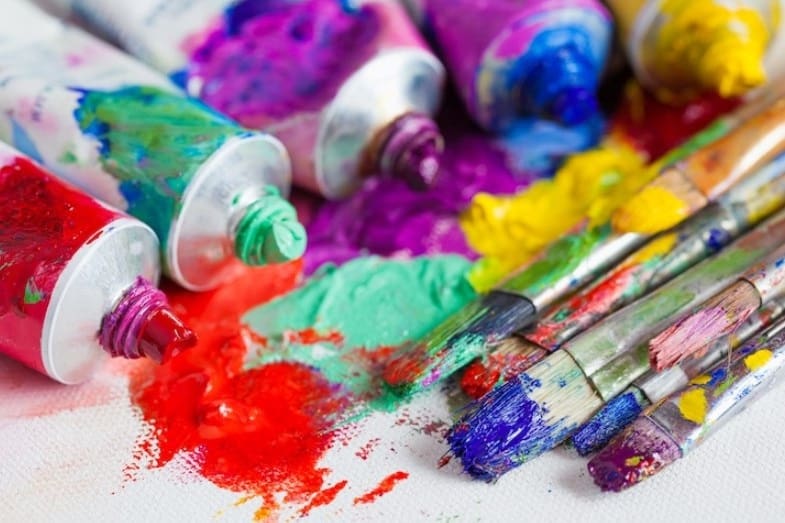Compared to acrylic and other mediums of painting, oil paint has a slower drying time. How long it takes for oil paint to dry depends on many factors. In this article, I’ll describe how long it takes for oil paint to dry, including the factors that affect its drying time.
How long does it take for oil paint to dry? Oil paint takes longer to dry than other paints. It can take as short as 24 hours and as long as 12 days for oil paint to fully dry. As a comparison, acrylic paint can dry in only a few minutes or up to an hour.
Four main factors that determine how long it takes for oil paint to dry are as follows:
- Color of the Pigment
- Pigment Quality
- Painting Environment
- Thickness of application
Oil paint properties both have advantages and disadvantages. One of the downsides of oil paint is that it dries slowly. However, many artists prefer using oil paint because they can manipulate it on canvas before it dries.
Read on to learn more about how long it takes for oil paint to dry and some helpful oil painting tips.
How Long Does It Take for Oil Paint to Dry?
In reality, the question, “How long does oil paint take to dry?” doesn’t have a specific answer. You will be surprised, as you read this article, how complicated oil paint’s drying process is. In oil paintings, dry to the touch is not completely dry. That is why many are confused, especially beginners to oil painting.
The solvents used in oil painting are turpentine and other substitutes. When these solvents oxidize, the top surface of the oil painting will be dry to the touch. Depending on several factors, oil paints can dry in 24 hours or 12 days.
The contents of the pigments used will influence the drying time as well. Pigments can be organic or naturally obtained. They can also be man-made solids. Dry to the touch time will depend on how the pigments react to the temperature and humidity of the place, the binder in the oil paint, and several other factors.
In other words, there is no fixed drying time with oil paints. Oil paints come in a wide variety of colors, made possible by the use of color pigments. One good thing about oil paint is that it does not darken when it dries. Acrylic paints do.
While it retains its vivid and vibrant colors, oil paint is not as fast drying as acrylic. Acrylic paint dries in as short as one hour, while some may quickly dry after 15 minutes. Depending on the temperature and humidity, oil paints can also take days or even weeks to dry.
As a rule of thumb, the thicker you apply oil paints, the longer your painting dries. For example, very thick impasto paintings may require as long as two years to dry completely. Only then will the oil paint be fully cured and ready for a protective coat of varnish. In contrast, paintings with a very thin application of oil paints will only take a few days to dry.
What Are the Factors That Affect Oil Paint Drying Time?
The drying time of oil paints usually depends on the following four main factors:
- Color of the Pigment – Some colors dry faster than others.
- Pigment Quality – Oil paints with more expensive pigments may dry slower than those with cheaper ones. More luscious colors also need good oil binders, which make them slow drying.
- Painting Environment – The humidity, temperature, wind, and light characteristics in the place where you paint.
- Thickness of Application – It goes without saying that the thicker the layer, the longer it will take for the paint to dry.
While there may be other factors that affect the oil paint’s drying time, the factors indicated above are the ones you need to be aware of.
Estimated Drying Times for the Most Popular Oil Paint Colors
The drying times listed below for the most popular oil paint colors are from the experiences of various artists who have been using this medium for their artwork.
Fastest Drying Oil Paint Colors (At least one day):
- Cobalt blue
- Prussian blue
- Raw sienna
- Burnt sienna
- Burnt umber
Medium Drying Oil Paint Colors (From 2 to 5 days):
- Cadmiums
- Leads
- Titanium white
- Viridian
- Zincs
Longest Drying Oil Paint Colors (From 5 to 12 days):
- Cadmium hues
- Ivory black
- Alizarin crimson
- Sap green
- Quinacridones

Estimated Drying Times of Different Oil Paint Mediums
Some painters use different oil paint mediums to get the certain fluidity they want to express in their artwork. The different mediums used by artists include safflower oil, poppy seed oil, and linseed oil. Some artists also use synthetic oils like alkyds.
How long for oil paint to dry with different mediums? The estimated drying time for different oil paint mediums are as follows:
- Slowest Drying Time – Poppy seed oil
- Moderate Drying Time – Safflower oil
- Fastest Drying Time – Linseed oil and alkyds
Those who want to keep their paintbrushes wet as they paint use poppy seed oil.
Two Ways You Can Speed Up the Drying Time of Oil Paints
We’ve answered the question “how long does it take oil paint to dry”, now let’s look at how you can speed up the drying time. While oil paints have their characteristic drying times, you can manipulate certain things to quicken the process. Here are two different methods to help speed up the drying time of oil paints.
Method 1. Control Your Environment
You have no way of controlling the contents of the oil paints you are using, but you can certainly control your painting environment. Here is how you can do this.
1. Keep the Room as Warm as Possible
Having a warm temperature will cause oil paints to dry faster. The room temperature where you keep your newly finished painting should be set to about 70°F (21°C). It is better to keep the room warmer because there’s really not too much temperature for oil paints. But be sure that even if the room is warm, you’d still feel comfortable.
2. Dry Your Painting in a Big and Well-lit Room
Bring your fresh oil painting to a big and well-lit room. The room should have low humidity to give the oil paints enough opportunity to oxidize. They will react with the air in the room and harden. The chemicals in the paint are actually changing during this process. So, you’ll need a room or place with low humidity, good air circulation, and a lot of natural light.
3. Use a Fan to Circulate the Air
Use a fan inside the room to let the air circulate. However, it will not speed up the drying time if you focus the fan’s blades directly on your painting. This drying method would be fine with watercolors but not with oil paints. What you will be doing is to help quicken the oxidation process of the oil paint so that it’ll dry faster. A low or medium fan setting will be enough.
4. Use a Dehumidifier
If you have a humid place, you need to use a dehumidifier. This machine will reduce the amount of water in the air. The drier the air, the faster the drying time of the painting. A small dehumidifier will be enough. Place it close to your fresh painting to increase the drying speed.
5. Additional Tip: Use a Paint Thinner
Get an odorless paint thinner and use it to thin the oil paint. With paint thinner, you can make a thick oil paint to acquire a watercolor-like consistency. Experiment on how much paint thinner you need to add to get your desired consistency and make your painting dry faster.
Method 2. Use a Better Way of Applying the Oil Paint
1. Paint on a Flat Canvas
Painting on a flat canvas will dry the oil paint faster than painting on a textured one. There are small crevices in a textured canvass where oil paints can lodge on. These are the places in the oil painting where drying will take longer. So, if you want your oil painting to dry faster, do your work on a flat canvas.
2. Use a Quick-drying Paint as Your Base Layer
To speed up the drying of your final artwork, use a quick-drying base paint. It is the easiest way to let all the succeeding paint layers dry faster. Oil paints that dry faster are those that contain copper, cobalt, and lead.
3. Use Glue Chalk Gesso to Seal the Canvass
Glue chalk gesso can be used as a primer applied to the canvas to seal it. It will absorb some amount of oil paint coming from the base layers. This seal will help the oil paints dry quickly. Only a thin layer of gesso is needed on the canvas. Dip a sponge brush on the gesso and apply it to the fresh canvass. Allow it to dry first before starting on your artwork.

4. Paint Thinly, Not Thickly
By painting in thin layers, your final artwork will dry faster. Conversely, if you want to paint with thick and bold strokes, expect that your final painting will take some time before it dries. A painting method you may want to practice is to start your painting with thin layers and then progress to the parts that need thick layers.
5. Reduce the Number of Layers in Your Painting
If you really need to finish and dry your painting quickly, paint a simple subject that only requires thin layers or washes of oil paints. Add the details later to make it more artsy and classy. The point is that your painting will take longer to dry if you apply many layers of paint to it.
6. Dry the Painting with a Heat Gun
You can use a heat gun to dry the oil paint faster. The heat from the heat gun will bake the oil paint and harden it. But don’t apply too much heat to your painting. Overheating the oil paint will cause it to turn yellowish or even crack. Keep your heat gun at a temperature of no more than 130°F or 54°C.
You should hold the gun just a few inches away from the surface of the painting. Slowly move as you heat the painting so that the heat can penetrate the paint layers under the surface. Don’t allow the nozzle of the gun to get into contact with the painting.
How to Choose Oil Paints That Dry Faster
1. For Earth Tones, Choose Oil Paints Made from Iron Oxides
Oil paints made from certain minerals dry faster. If you are required to finish the painting in a short time, use oil paints with earth tones. These earth colors are usually made from iron oxides. Compared to other pigments, they dry faster by several days. Stay away from cadmium and ivory black since they tend to dry slower than other pigments.
2. For Other Tones, Choose Oil Paints Made with Cobalt and Lead
Oil paints made with cobalt and lead are known to be fast drying. Using them for other hues in your painting will cause the paint to dry faster, too.
3. Choose Paints That Contain Linseed Oil
The oil used in making the paint affects its drying time. Those made with linseed oil are known to dry faster than others. You can find them in most stores that sell art supplies.
4. Mix Linseed Oil with Your Oil Paints
You can still use oil paints that do not contain linseed oil by mixing it with the paints. Linseed oil tends to dry faster than other kinds of oils used in oil painting. So, incorporating just a little amount of linseed oil will make these paints dry faster. And so will your final artwork.
Conclusion – How Long Does It Take for Oil Paint to Dry?
So, to answer the initial question: How long does it take for oil paint to dry? There is no fixed drying time for oil paints. Oil paints dry slower than other mediums, and the time it takes for oil paint to dry depends on many factors.
These factors include the oil paint’s type and color plus the conditions in the place where you are painting. Environmental factors include humidity, temperature, light, and wind, among others. But in figures, it can take as short as 24 hours and as long as 12 days to dry oil paints.


![How Long Does DayQuil Last? [How Long It Stays in Your System] how long does dayquil last](https://howchimp.com/wp-content/uploads/2021/06/how-long-does-dayquil-last-300x200.jpg)
![How Long Does DHL Take to Deliver? [DHL Delivery Time] How Long Does DHL Take to Deliver](https://howchimp.com/wp-content/uploads/2021/05/how-long-does-DHL-take-to-deliver-300x200.jpg)


![Read more about the article Baby Brown Recluse Spider: How to Identify, Is It Dangerous? [With Pictures]](https://howchimp.com/wp-content/uploads/2021/05/baby-brown-recluse-300x200.jpg)